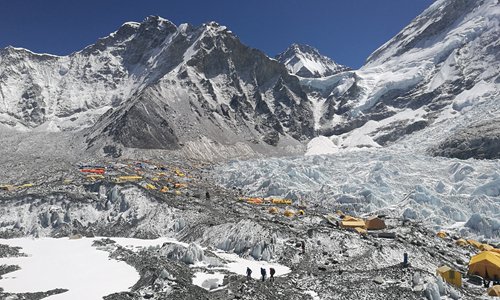
Climbers and their guides prepare to ascend the world's tallest mountain Qomolangma at the South Base Camp in Nepal on May 11. (Photo/Courtesy of Han Zijun)
○ The number of climbers trying to scale the world's tallest mountain will be higher than ever this year
○ Deadly traffic jams will likely happen again, so precautions such as staggering climbers' departure times and setting up two-way routes have been taken
○ The number of Chinese climbers is increasing and domestic agencies are planning to attract more climbers to the less popular northern route in Tibet
Traffic jams are an annoyance when we're trying to get around town. But at over 8,000 meters above sea level they can be deadly. This is the dilemma facing climbers and travel agencies on Mount Qomolangma, commonly known in the West as Mount Everest. This year, the busiest ever, traffic jams in the "death zone" will almost certainly occur again.
The 8,844-meter mountain has steep icy slopes, treacherous conditions and low oxygen level. Climbers who stand in one spot for hours face freezing to death or running out of air to breathe.
With the approach of the best time of year for scaling the world's highest peak, which lies on the border between Nepal and China, the base camps on opposite sides of Mount Qomolangma see their busiest season, as hundreds of trekkers from all around the world get ready for the climb of their lives.
This year, the total number of climbers may surpass 1,000, more than ever before.
The Nepali government issued 371 climbing permits to foreigners this year, the most since the mountain was first scaled in 1953. Including local Sherpa mountain guides, around 800 people will attempt the climb from the Nepali side this year, according to the Associated Press.
The number of climbers didn't grow on the north side this year, said Tashi Tsering, a senior guide who has climbed Qomolangma 11 times and is now leading a climbing team at the North Qomolangma Base Camp in Southwest China's Tibet Autonomous Region.
"There are about 200 climbers from the north, almost the same as last year," Tashi, who works for the Tibet Himalaya Expedition Company, a leading Chinese trekking and adventure agency, told the Global Times. "We have limited the number. Besides, we have been emphasizing that reaching the summit is not the most important thing, safety is."
Safety on the slopes
Ma Liyamu, a Chinese climber who led a team up Qomolangma from Nepal last year, said there will more people climbing the mountain this year because natural disasters in 2014 and 2015 prevented permit-holders from climbing.
Alan Arnette, a US mountaineer who summitted Qomolangma at age 54 in 2011, agrees.
"Both Nepal and China extended climbing permits after the 2015 earthquake so many people, 70 just on the Nepal side, are using permits before they expire. Also, 2016 was a good year on Qomolangma, tricking people into thinking it is safe," Arnette told the Global Times on Tuesday via e-mail.
Several traffic jams happened on Qomolangma last year.
Mingma Tenzi Sherpa, a Nepali guide who has reached the summit of Qomolangma six times, said he and his clients were delayed four hours on their way to the summit, waiting for an hour at the bottom of the famous "Hillary Step," a nearly vertical rock face approximately 8,790 meters up, the last steep challenge of the ascent, the Associated Press reported.
Two of his clients lost toes during the wait, the Sherpa told the news agency.
"When standing still, climbers get cold and use up their oxygen. Frostbite can develop on hands and toes. In some cases people can die," Arnette said.
The summit window for climbers from Nepal has just arrived as storms delayed repair work on the road to the summit for several days. Climber Han Zijun from Shanghai who ascended the peak from Tibet last May plans to try the southern route this year.
"Everyone is worried about the heavy traffic. Weather conditions suitable for an ascent only last about a week. It will be crowded as hundreds of climbers will be trying to reach the summit within just a few days," Han told the Global Times.
"The team leaders will negotiate in order to stagger leaving times before the last ascent. For myself, I will tell the Sherpa in advance to turn down my oxygen flow when we meet congestion," she said. "But all I can do is pray for no traffic jams and that the climber ahead moves quickly."


















































